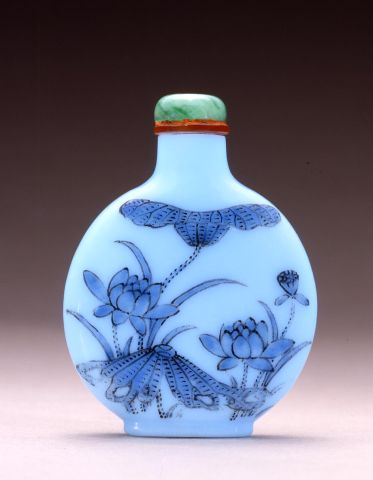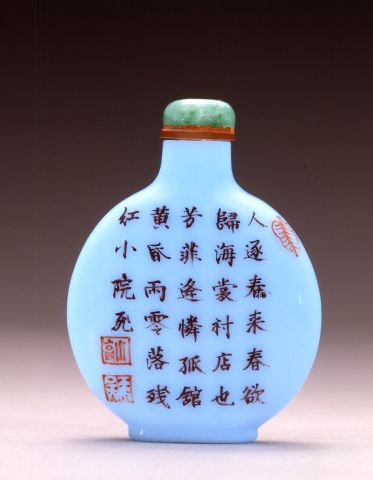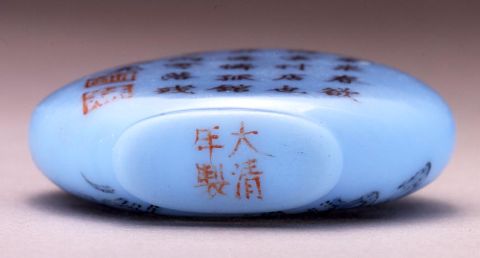


Bottle ID: 00336
OPAQUE BLUE, FLOWERS & POEM
Date: 1750-1800
Height: 58 mm
Glass, of flattened rounded form, the opaque blue body enameled on one side in blue and black tones with two blossoming lotus flowers surrounded by leaves and pods rising from the water; the reverse with a twenty-eight character poem in regular script with a iron-red enamel leaf to the upper right shoulder reading:
The more one urges spring to come, spring wants to leave -
A country inn with its crab apples is fragrant with blossoms too.
I met rain at dusk at this pitifully lonely place.
Where withered fallen reeds fly about in its little courtyard.
And followed by two iron-red seals, reading: "Shangao" and "Wu Yuchuan" respectively; the flat base with a four character Da Qing nianzhi mark.
Similar Examples:
Crane Collection no. 247
Crane Collection no. 219
Parke-Bernet Galleries Inc., New York, February 20, 1970, lot 193, Collection of Mrs. Elmer A. Claar, Part Two.
Christie, Manson & Woods, St. James's, London, June 18, 1973, lot 94, The Ko Family Collection, Part III.
Moss, Hugh, Victor Graham and Ka Bo Tsang. The Art of the Chinese Snuff Bottle - The J & J Collection, 1993, Vol. I, pp. 334-338, nos. 195 and 196.
Provenance:
Clare Lawrence Ltd.
Sotheby's, New York, October, 25, 1997, lot 34
Gerry P. Mack
Exhibited:
Annual Convention ICSBS Toronto, October 2007
Three enameled glass bottles bearing a Da Qing nianzhi mark are in the J & J Collection. One is enameled on milk-white glass and bears no signature. The other two are of more interest because they bear the same mark as the Crane bottle and also have the signature Wu Yuchuan. In addition, one of the two bottles has the seal Shangao enameled on it. Although the J & J examples are catalogued as Imperial wares, the placing of a signature on an object is odd. The use of an individual name on Imperial wares is highly unusual, if at all permissable. There is no precedent to this on snuff bottles and that alone makes it highly unlikely that this group is Imperially made. Hugh Moss records five other similarly inscribed bottles with this signature bringing the total to eight with this bottle. To further confuse the issue, some of the known examples have this signature accompanied by a Guyue Xuan mark. One connection to the Palace Workshops is provided by the seal Shangao, as this was one of the most popular seals used on the highly Imperial earlier group of Qianlong enamel wares which were all manufactured in the Palace Workshops and which are still in the Imperial Collection today.
While the designs of some of the Palace enamels appear on this group of bottles, it may be that these were simply copied by enamelers who worked inside the Palace, and subsequently returned to their homes. It is a dangerous premise to suggest that only bottles (of any material ) produced in the Palace are of a high quality. Other centers of enameling included Yangzhou, Guangzhou and Yunnan, and also private workshops in Beijing.
The lotus is a popular subject on snuff bottles, being a symbol of purity. It occurs on both Imperial and non-Imperial bottles of varying materials. On the Wu Yuchuan group of bottles, it appears to be one of the most popular subject matters and is often accompanied by a single poem. Intriguingly, an enameled glass bottle with a lotus design is in the Gulbenkian Museum in Durham, U.K. where it is listed as having belonged to Qian Lipao of the Qing Dynasty. There is no other information given about Qian and no indication of when he might have come into possession of this bottle or indeed whether it was originally made for him.
Moss has recently argued for an Imperial attribution to this group linking it stylistically to the Guyue Xuan group dated 1767-1799 (see Crane no. 247) citing the presence of a leaf seal and two others: "Zhonghe" and "Shangao" (which appear on Imperial wares in the Palace), together with the common use of the lotus as a subject matter and the similar use of palettes. Interestingly, he does not attempt to suggest that the specific enamelers of this group were the same hands that enameled the Imperial wares. "Wu Yuchuan" glass bottles are found in a series of colors, the majority being of a milk-white color, although the Crane bottle is executed in blue and black enamel on an opaque pale blue ground.
The jury is still out on this, however, and with no convincing dated bottles to indicate any particular reign, it is hard to attribute this group to the Palace Workshops. The parallels to the other "lotus" group of enameled glass bottles with Guyue Xuan basemarks may incline collectors to attribute the group towards a private enameler working outside the Palace in the late eighteenth century.
< Back to full list
 English
English 中文
中文